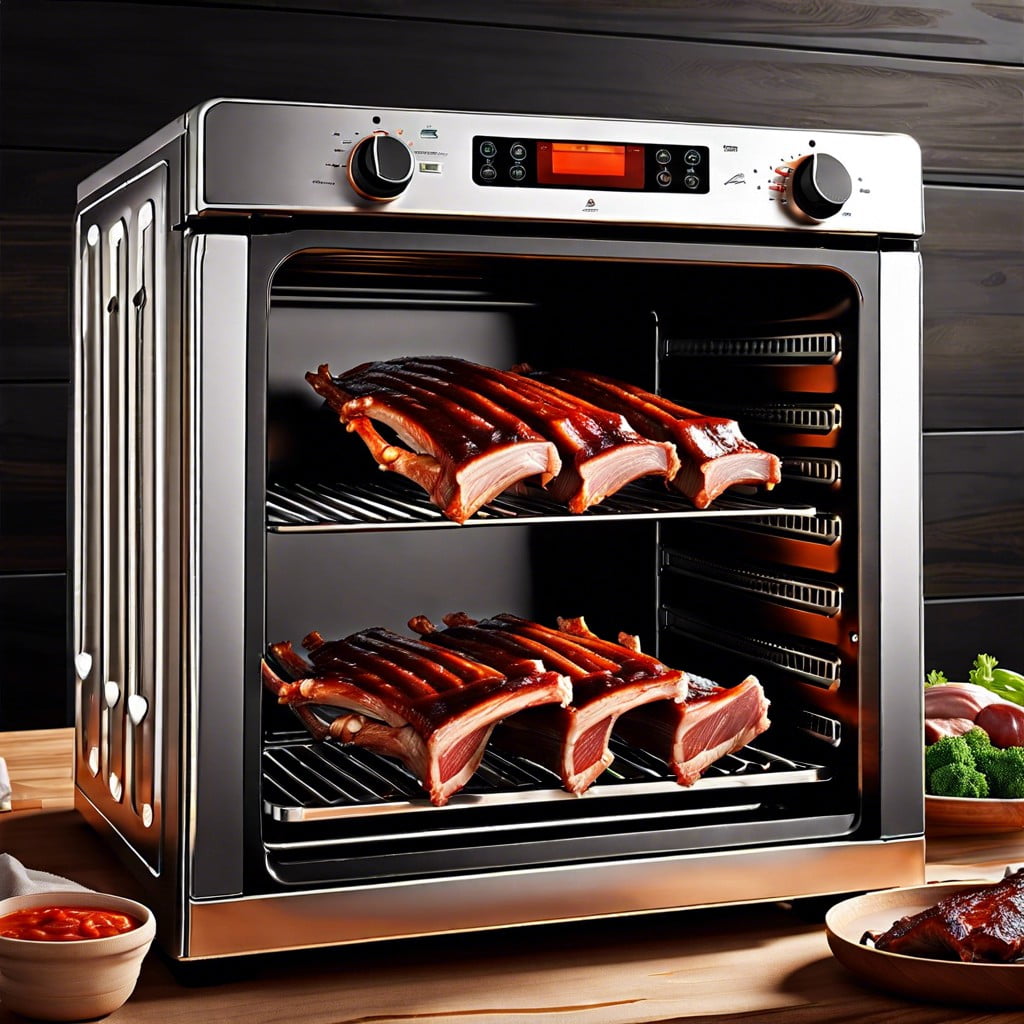Learn the best methods for reheating ribs to preserve their flavor and moisture without drying them out.
Key takeaways:
- Properly store ribs in foil or plastic wrap for up to three days.
- Let ribs rest at room temperature before reheating.
- Reheat ribs in the oven at 250°F for 20-30 minutes.
- Wrap ribs in foil to maintain moisture during reheating.
- Use a meat thermometer to ensure ribs reach a safe internal temperature of 145°F.
Storage and Preparation for Reheating

Before diving into the reheating process, proper storage is crucial. Wrap ribs tightly in foil or plastic wrap to seal in moisture. Refrigerate for up to three days.
Before reheating, let them rest at room temperature for about 30 minutes to ensure even warming. Trim any dried-out edges to enhance the final eating experience.
Safe preparation sets the foundation for perfectly reheated ribs.
Reheating in the Oven: Step-by-Step
To ensure your ribs return to their former glory in the oven, preheat it to 250°F. This temperature is key—hot enough to warm thoroughly, yet gentle enough to prevent drying out.
Wrap the ribs tightly in foil, which mimics the low-and-slow cooking environment ribs benefit from, capturing moisture and heat. Add a splash of apple cider vinegar or broth before sealing for a boost of steam and flavor.
Place the foil-wrapped package on a baking sheet in the middle rack. Heat for 20-30 minutes, depending on size and thickness. Larger portions may require extra time.
The foil can be opened in the last few minutes to restore exterior texture, but do so judiciously; too much direct heat can toughen the meat.
Use this oven-steaming technique, and you’ll find that reheating ribs is not just a recovery mission, but an opportunity to rejuvenate them.
The Secret to Moist Reheated Ribs
To maintain succulence during reheating, wrap the ribs in foil. This creates a steamy environment that prevents moisture loss.
For an extra layer of flavor and tenderness, consider adding a splash of apple juice, beer, or broth before sealing the packet.
Another tip is to gently heat the ribs; a moderate oven temperature – around 250°F (120°C) – allows the meat to warm up without drying out.
Additionally, leveraging the residual heat is smart. Turn off the oven a few minutes before the ribs are fully reheated, letting them bask in the warmth without the risk of overcooking.
These measures ensure that ribs emerge from the oven nearly as juicy as when they were first cooked.
Identifying When Ribs Are Perfectly Reheated
Achieving the ideal temperature for reheated ribs without overcooking them is crucial. Use a meat thermometer to check that the internal temperature has reached 145°F – the safe minimum for cooked pork set by the USDA. To ensure the most accurate reading, insert the thermometer into the thickest part of the meat, avoiding contact with the bones.
Trust your senses as well; the ribs should be steaming gently and the exterior should have a slight sizzle, indications that they’re warmed throughout without becoming dry. The meat should yield easily with a fork and show no signs of pinkness or rawness at the bone.
Lastly, observe the texture. Overheating could cause the ribs to toughen and lose their succulent quality. If the meat retains its tenderness and the barbecue sauce has regained its stickiness, you’ve likely hit the sweet spot.
Safety Considerations for Reheated Meat
When reheating ribs, or any meat, food safety should never take a backseat. Ensure ribs reach an internal temperature of 165°F to prevent foodborne illnesses caused by bacteria. Use a meat thermometer to accurately gauge this, inserting it in the thickest part of the rib meat, avoiding the bone for a true reading.
Leftovers should be heated only once, as repeated warming can compromise their quality and safety. If ribs have been at room temperature for more than 2 hours, or 1 hour if it’s above 90°F outside, it’s best to err on the side of caution and discard them to avoid the risk of food poisoning.
Remember, keeping these guidelines in mind helps ensure both a delicious and safe barbecue experience.

